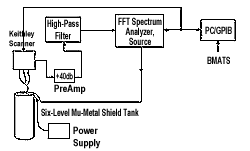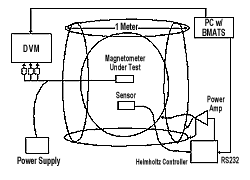Thermal Cycling Test

A typical thermal cycling test will consist of 1 cycle with a room temperature measurement, then a cold measurement and then a hot measurement, or as specified by customer’s program requirements. The test will take place in an ambient pressure, nonmagnetic environmental chamber within the Billingsley facility. Instrument outputs will be monitored and recorded during thermal cycling tests.
Noise Testing
The is placed in a “six level” magnetic shield (fluxtank) and connected to the Billingsley Aerospace noise test setup. This setup consists of a 40 dB low noise amplifier, a 0.005 Hz Krohn-Hite high-pass filter and a Stanford Research

SR770 FFT spectrum analyzer. The spectrum analyzer accumulates at least 1024 data samples and then measures the RMS noise at 1 Hz. The resultant noise must be < 25picoTesla/RMS Hz-1/2 @ 1Hz. This test is performed automatically and repeated for the other two axes using the BMATS application to multiplex and analyze the SR770 data. Frequency response The instrument is placed in a “six level” shield tank. The instrument is stimulated with the Stanford Research SR770’s spectrum analyzer’s internal frequency source. The TFM100S -3dB bandwidth will be determined by the spectrum analyzer response. Automatic multiplexing of the different sensor axes and data analysis will be done using the BMATS application to control the SR770 on its GPIB bus. Each axis must have a -3dB point at >500 Hz.
Orthogonality
The instrument is placed in a closed-loop Helmholtz coil system. The BMATS orthogonality application is run and the sensor’s orthogonality is calculated using the dot products of the generated field values. The sensors must be orthogonal to better than ±1°. A report is generated which reports the orthogonality of each axis.
